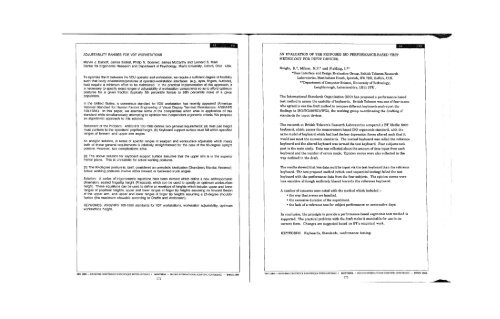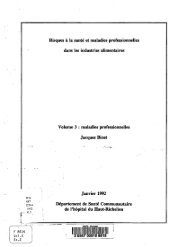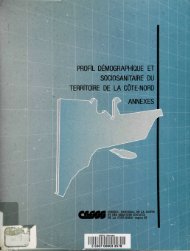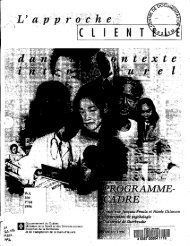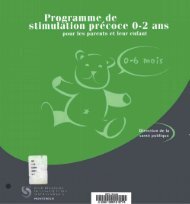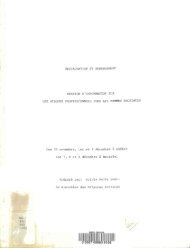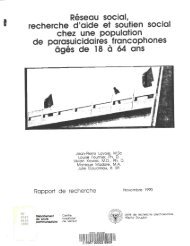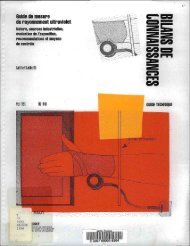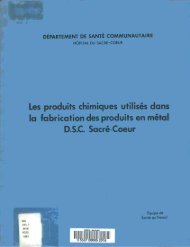ADJUSTABILITY RANGES FOR VDT WORKSTATIONSMarvin J. Dainoff, James Balliett, Phillip N. Goernert, James McCarthy and Leonard S. MarkCenter for Ergonomie Research and Department of Psychology, Miami University, Oxford, OhioTo optimize the fit between the VDU operator and <strong>work</strong>station, we require a sufficient <strong>de</strong>gree of f<strong>le</strong>xibilitysuch that body orientations/postures at operator-<strong>work</strong>station interfaces (e.g., eyes, fingers, buttocks,feet) require a minimum effort to be maintained. In the practical imp<strong>le</strong>mentation of this approach, itis necessary to specify exact ranges of adjustability of <strong>work</strong>station components so as to afford optimumpostures for a given fraction (typically 5th percenti<strong>le</strong> fema<strong>le</strong> to 95th percenti<strong>le</strong> ma<strong>le</strong>) of a givenpopulation.In the United States, a consensus standard for VDU <strong>work</strong>station has recently appeared (AmericanNational Standard for Human Factors Engineering of Visual Display Terminai Workstations: ANSI/HFS100-1988.) In this paper, we examine some of the comp<strong>le</strong>xities which arise in application of thisstandard whi<strong>le</strong> simultaneously attempting to optimize two in<strong>de</strong>pen<strong>de</strong>nt ergonomie criteria. We proposean algorithmic approach to this solution.Statement of the Prob<strong>le</strong>m: ANSI/HFS 100-1988 <strong>de</strong>fines two general requirements: (a) Seat pan heightmust conform to the operators' popliteal height, (b) Keyboard support surface must fall <strong>with</strong>in specifiedranges of forearm and upper arm ang<strong>le</strong>s.An analytic solution, in terms of specific ranges of seatpan and <strong>work</strong>surface adjustab<strong>le</strong> which meetsboth of these general requirements is relatively straightforward for the case of the 90-<strong>de</strong>gree uprightposture. However, two complications arise.(a) The above solution for keyboard support surface assumes that the upper arm is in the superiorfrontal plane. This is unrealistic for actual <strong>work</strong>ing postures.(b) The 90-<strong>de</strong>gree posture is, itself, consi<strong>de</strong>red an unrealistic i<strong>de</strong>alization (Grandjean, Mandai, Kroemer).Actual <strong>work</strong>ing postures involve either forward or backward trunk ang<strong>le</strong>s.Solution: A series of trigonometric equations have been <strong>de</strong>rived which <strong>de</strong>fine a new anthropometricdimension, seated fingertip height (Pheasant), which can be used to specify an optimum <strong>work</strong>surfaceheight. These equations can be used to <strong>de</strong>fine an envelope of heights which inclu<strong>de</strong>: upper and lowerranges of popliteal heights, upper and lower ranges of finger tip heights assuming no forward f<strong>le</strong>xionof the upper arm, and upper and lower ranges of finger tip heights assuming a 25-<strong>de</strong>gree shoul<strong>de</strong>rf<strong>le</strong>xion (the maximum allowab<strong>le</strong> according to Chaffin and An<strong>de</strong>rsson).KEYWORDS: ANSI/HFS 100-1988 standards for VDT <strong>work</strong>stations, <strong>work</strong>station adjustability, optimum<strong>work</strong>surface height.USA.AN EVALUATION OF THE PROPOSED ISO PERFORMANCE-BASED TESTMETHOLOGY FOR INPUT DEVICES.Knight, D.*, Milner, N.P.* and Fielding, I.***User Interface and Design Evaluation Group, British Te<strong>le</strong>com ResearchLaboratories, Mart<strong>le</strong>sham Heath, Ipswich, IP5 7RE, Suffolk, U.K."""Department of Computer Science, University of Technology,Loughborough, Leicestershire, LE11 3TU .The International Standards Organisation (ISO) has proposed a performance-basedtest method to assess the usability of keyboards. British Te<strong>le</strong>com was one of four teamswho agreed to use the draft method to compare different keyboards and report thefindings to ISO/TCI59/SC4/WG3, the <strong>work</strong>ing group co-ordinating the drafting ofstandards for input <strong>de</strong>vices.The research at British Te<strong>le</strong>com's Research Laboratories compared a BT Merlin 5000keyboard, which passes the measurement-based ISO ergonomie standard, <strong>with</strong> thesame mo<strong>de</strong>l of keyboard which had had the key <strong>de</strong>pression forces altered such that itwould not meet the currents standards. The normal keyboard was cal<strong>le</strong>d the referencekeyboard and the altered keyboard was termed the test keyboard. Four subjects tookpart in the main study. Data was col<strong>le</strong>cted about the amount of data input from eachkeyboard and the number of errors ma<strong>de</strong>. Opinion scores were also col<strong>le</strong>cted in theway outlined in the draft.The results showed that <strong>le</strong>ss data could be input via the test keyboard than the referencekeyboard. The test proposed method (which used sequential testing) fai<strong>le</strong>d the testkeyboard <strong>with</strong> the performance data from the four subjects. The opinion scores were<strong>le</strong>ss sensitive although uniformly biased towards the reference keyboard.A number of concerns were noted <strong>with</strong> the method which inclu<strong>de</strong>d :-• the way that errors are hand<strong>le</strong>d.• the excessive duration of the experiment.• the lack of a reference test for subject performance on consecutive days.In conclusion, the princip<strong>le</strong> to provi<strong>de</strong> a performance-based ergonomie test method issupported. The practical prob<strong>le</strong>ms <strong>with</strong> the draft make it unsuitab<strong>le</strong> for use in itscurrent form. Changes are suggested based on BT's empirical <strong>work</strong>.KEYWORDS:Keyboards, Standards, conformance testing.TEV 1989 — DEUXIÈME CONFÉRENCE SCIENTIFIQUE INTERNATIONALE • MONTRÉAL • SECOND INTERNATIONAL SCIENTIFIC CONFERENCE — WWDU 1989172TEV 1989 — DEUXIÈME CONFÉRENCE SCIENTIFIQUE INTERNATIONALE • MONTRÉAL • SECOND INTERNATIONAL SCIENTIFIC CONFERENCE — WWDU 1989173
WÊÊÈMmMTFA AS A METRIC FOR COMMUNICATING VDU DISPLAY QUALITYYingduo Feng, Testing and Research Laboratories, Swedish Te<strong>le</strong>communicationsAdministration, 123 86 Farsta, Swe<strong>de</strong>n, andOlov Ostberg, Development Council, Swedish Agency for Administrative Development,Box 34107, 10026 Stockholm, Swe<strong>de</strong>n.Manufacturers of Visual Display Units (VDUs) need a metric for monitoring andcommunicating product quality. Purchasers se<strong>le</strong>cting between the many VDUs availab<strong>le</strong> onthe market need a metric for evaluating the relative merits of looks, performance and cost.End users need a metric in objectifying <strong>work</strong> experiences for participatory system <strong>de</strong>sign andnegotiations on compensation and allowances. Governmental authorities need a metric forregulating safety and health issues in occupational VDU usage. Image quality is no doubt acommon <strong>de</strong>nominator among these various needs. Accordingly, a metric for the assessmentof image quality has for long been on the wish-list of the VDU community.A great many parameters interact in a VDU setting, of which image quality is only one.Image quality in turn can be broken down into (interacting) components such asaddressability, temporal and spatial resolution, color spectrum, and to<strong>le</strong>rance to variedmo<strong>de</strong>s of usage and environmental factors. Any sing<strong>le</strong> measure, be it composite or not, isthus bound only to give limited information on the merits of a VDU <strong>display</strong>. With this inmind, the Modulation Transfer Function Area (MTFA) metric is analyzed and put to a test.National and international standards institutions have recently adopted MTFA as a. spatialresolution metric for monochrome CRT <strong>display</strong>s. Unfortunately, MTFA is sometimes seenas the. VDU quality measure. MTF(A) is a long trusted resolution metric in photography,but its usefulness as a <strong>display</strong> metric is yet to be proven. It is difficult and costly to measure,it has a low correlation <strong>with</strong> subjective <strong>display</strong> quality, and its power of discrimination isquestionab<strong>le</strong>."The MTFA metric of a <strong>display</strong> shall have a value of at <strong>le</strong>ast 5," says the American NationalStandards Institute. Even though no information is availab<strong>le</strong> on the rationa<strong>le</strong> for thisstatement, it has been repeated by other standards institutions. The National SwedishInstitute of Radiation Protection has performed MTFA measurements of some 100 VDUmo<strong>de</strong>ls. Virtually every one reached a value of 5, but some 50 % of the samp<strong>le</strong> did not reachan MTFA value of 7. This <strong>le</strong>vel would be more in accordance <strong>with</strong> the Swedish view oncurrent VDU <strong>display</strong> resolution quality. An MTFA value of at <strong>le</strong>ast 7 would also be inaccordance <strong>with</strong> the research findings on subjectively acceptab<strong>le</strong> photographic image quality.The current pass/fail criterion is c<strong>le</strong>arly premature or too <strong>le</strong>nient.Visual performance <strong>with</strong> color CRT <strong>display</strong>s:evaluation of human engineering gui<strong>de</strong>linesMichael L. MatthewsDepartment of PsychologyUniversity of GuelphGuelph, Ontario NIG 2W1.1.2 IS"In recent years a number of recommendations concerning the use of color in CRT <strong>display</strong>s haveemerged. These have focussed on both visual performance and subjective well-being. A series ofexperiments will be <strong>de</strong>scribed to evaluate some of the current recommendations. In particular, thea<strong>de</strong>quacy of the proposed metric <strong>de</strong>ltaE(Yu'v)' to accurately predict visual performance will beassessed. In addition, recommendations on the avoidance of the use of red and blue, either alone,or in combination, will be experimentally evaluated.A series of experiments was conducted using two types of visual task: these were the search forcharacter/symbol information in a cluttered <strong>display</strong> and proofreading of text. Performance measureswere speed and accuracy in both cases. In addition, subjective well-being was assessed using achecklist and rating form. Task duration was one hour. Color/luminance differences between theforeground and background were systematically manipulated to yield a range of <strong>de</strong>ltaE (dE) valuesfrom 80 to 160. The luminance range employed was from 5 to 85 cd/m 2 and there were six colorconditions: blue, red, green and white each on a black background and a red/blue and blue/redbackground/foreground combination. The subject population was ma<strong>le</strong>s and fema<strong>le</strong>s in the agerange 18-25 years old.Data were analysed using multivariate analysis of variance (MANOVA) followed by plannedcomparisons of performance across color conditions. For the visual search task, differences amongsuch conditions and across dE <strong>le</strong>vels were small, typically <strong>le</strong>ss than 7% for both tasks. Blue/blackand red/blue gave consistently faster response times (by about 10%) than other color combinations.In the proofreading task, at dE=80, reading rates varied from a low of 78 words per minute (wpm)for blue to a high of 104 wpm for white. Fastest reading rates were obtained at dE=140 for blue (104wpm) and red (106 wpm) and dE=160 for green (101 wpm) and white (107 wpm). All of themultichromatic conditions showed reading rates which were significantly faster (approximately 15%)than the monochromatic conditions.There was no evi<strong>de</strong>nce for differential fatigue <strong>with</strong> any specific color combination. DeltaE fai<strong>le</strong>dto predict performance and there was c<strong>le</strong>ar evi<strong>de</strong>nce of performance differences across colors but<strong>with</strong>in a particular <strong>le</strong>vel of <strong>de</strong>ltaE. There was no support for the gui<strong>de</strong>line that red or blue <strong>display</strong>sshould be avoi<strong>de</strong>d.Overall, the results <strong>de</strong>monstrate that the imp<strong>le</strong>mentation of color in medium resolution <strong>display</strong>s, atluminance <strong>le</strong>vels which might be typically found in operating environments, has litt<strong>le</strong> consequencefor either performance or well-being in tasks which resemb<strong>le</strong> activities wi<strong>de</strong>ly conducted using theCRT medium.KEYWORDS: Image quality, Resolution, MTFA, StandardsTEV 1989 — DEUXIÈME CONFÉRENCE SCIENTIFIQUE INTERNATIONALE • MONTRÉAL • SECOND INTERNATIONAL SCIENTIFIC CONFERENCE — WWDU 1989175TEV 1989 — DEUXIÈME CONFÉRENCE SCIENTIFIQUE INTERNATIONALE • MONTRÉAL • SECOND INTERNATIONAL SCIENTIFIC CONFERENCE — WWDU 1989173


